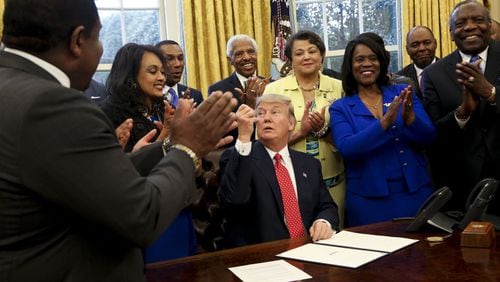When President Donald Trump last year held an impromptu meeting in the Oval Office with presidents of many of the nation’s historically black colleges and universities, it was a moment that sparked speculation of unprecedented support for the schools.
“With this executive order, we will make HBCUs a priority in the White House — an absolute priority,” Trump said at the time.
Has Trump made HBCUs a priority? The reviews are mixed.
Some note the Trump administration and Congress approved changes last year that resulted in more money for many HBCU students to pay for college. Others say Trump can do far more, but are skeptical he will.
Ronald A. Johnson, who resigned this month as Clark Atlanta University’s president, says there’s been tangible results, such as an increase for HBCUs in federal dollars given for faculty development, management and other programs to strengthen the schools. The total rose by approximately by $35 million, from about $244 million in fiscal year 2017 to more than $279 million in fiscal year 2018, according to U.S. Department of Education data.
“There was something beneficial to the slings and arrows we got,” Johnson said of meeting with Trump.
Spelman College President Mary Schmidt Campbell credited “heightened interest” from Congress for the additional support.
Johnny C. Taylor Jr., who helped convene the meetings, says there have been other positives, such as the Trump administration increasing the maximum Pell Grant — money for college students from low-income households by $175— from $5,920 for the last school year to $6,095 this year. By some estimates, about 70 percent of HBCU students receive Pell Grants.
Taylor, chairman of the President’s Board of Advisors on Historically Black Colleges and Universities, supported Hillary Clinton during the 2016 presidential race (she promised $25 billion in investments to HBCUs), but talked to Trump and his aides during the campaign in case he won. Taylor said another beneficial result from the White House visit was the Trump administration’s decision to forgive more than $300 million in hurricane relief loans provided to four HBCUs impacted by hurricanes Katrina and Rita in 2005.
"What's occurring is they have responded and have done better — more than expected," said Taylor, president and CEO of the Society for Human Resource Management. "HBCUs have done well."
Former Morehouse College President John S. Wilson Jr. is so far underwhelmed by the Trump administration’s support for HBCUs, recalling Clinton’s campaign promises and the president’s comments of doing something “historic” for the schools.
“Mr. Trump’s legacy in relation to HBCUs may end up being a historic disappointment for those who dared to have high expectations of him,” said Wilson, who served as executive director of the White House Initiative on HBCUs during the Obama administration.
Ultimately, Wilson believes, support for HBCUs must come from alumni and the private sector, noting more money to colleges flows from private gifts and grants than from Uncle Sam.
“I don’t know if things will get better with a new Congress. I stopped paying too much attention to the federal flow of money to HBCUs a long time ago,” said Wilson, a senior adviser at Harvard University. “I think (HBCUs) should remain healthy because they’re national treasures. But I think the private sector is where the emphasis should be.”







